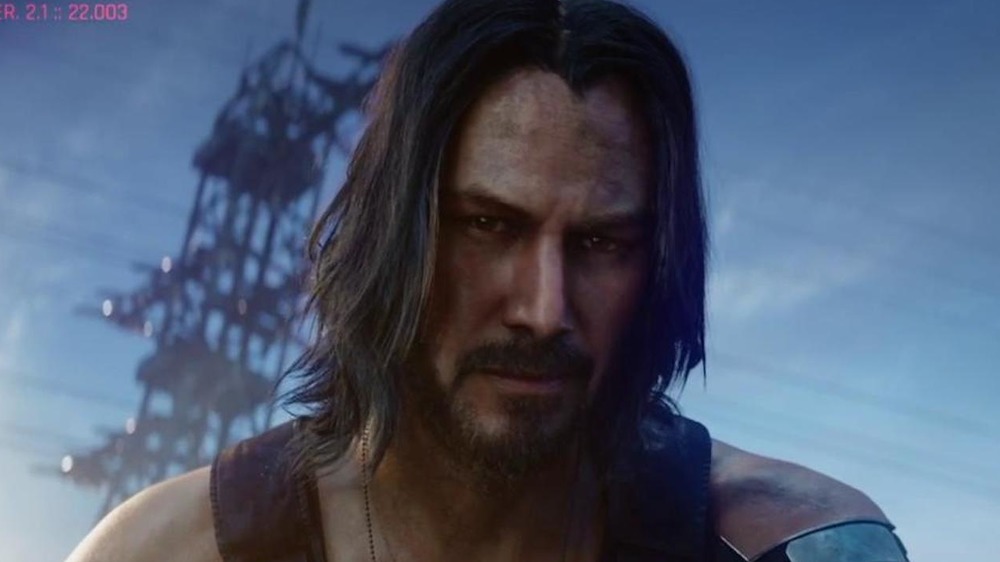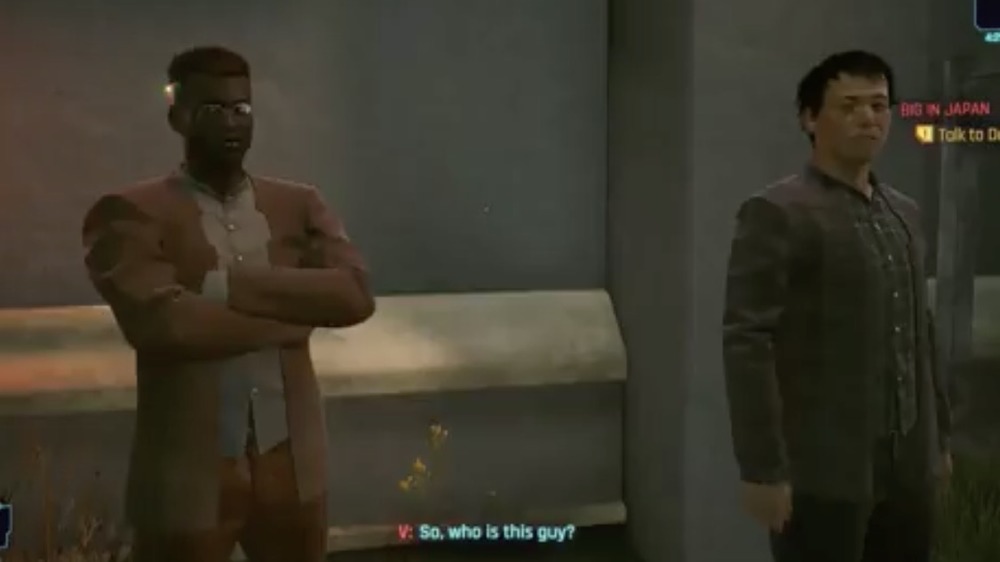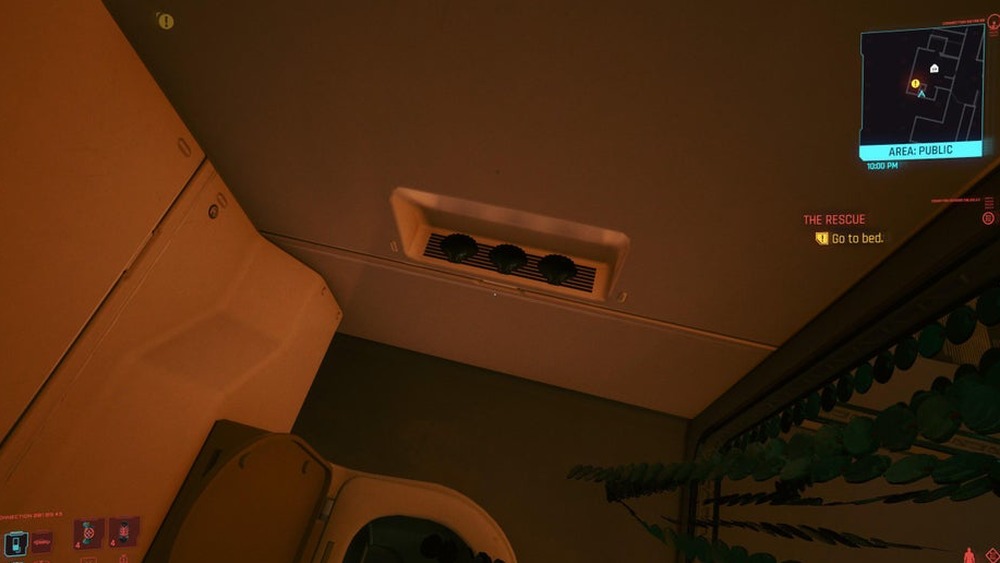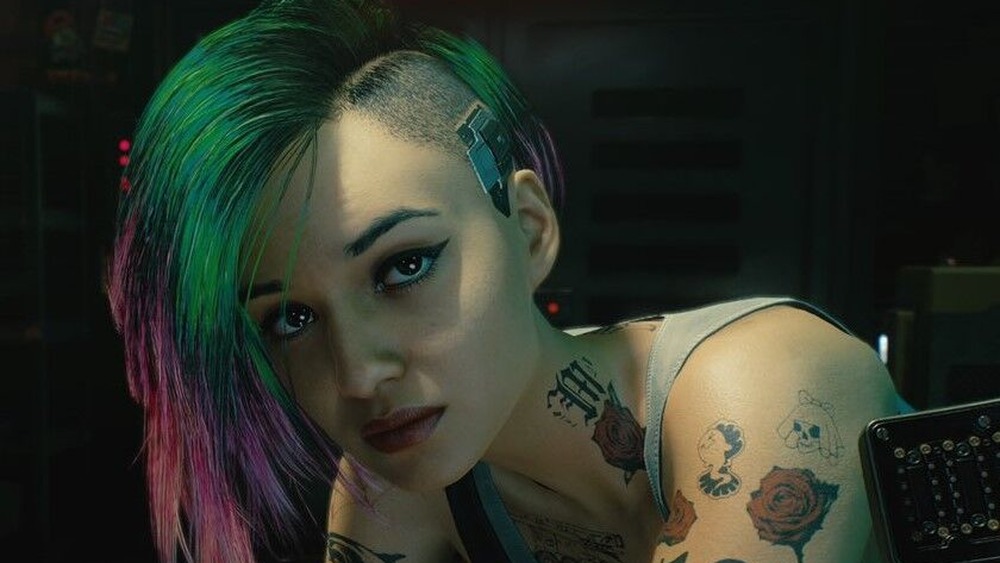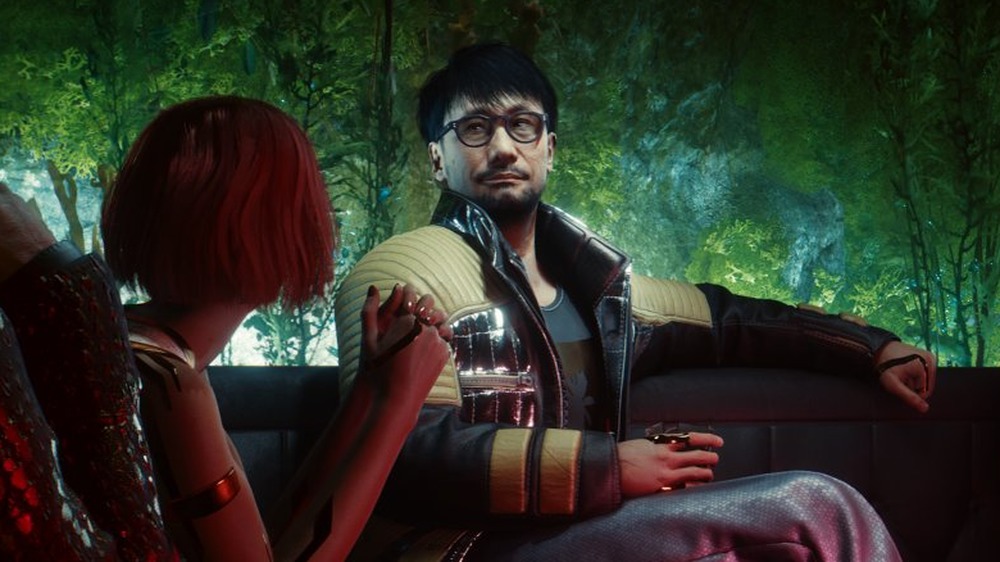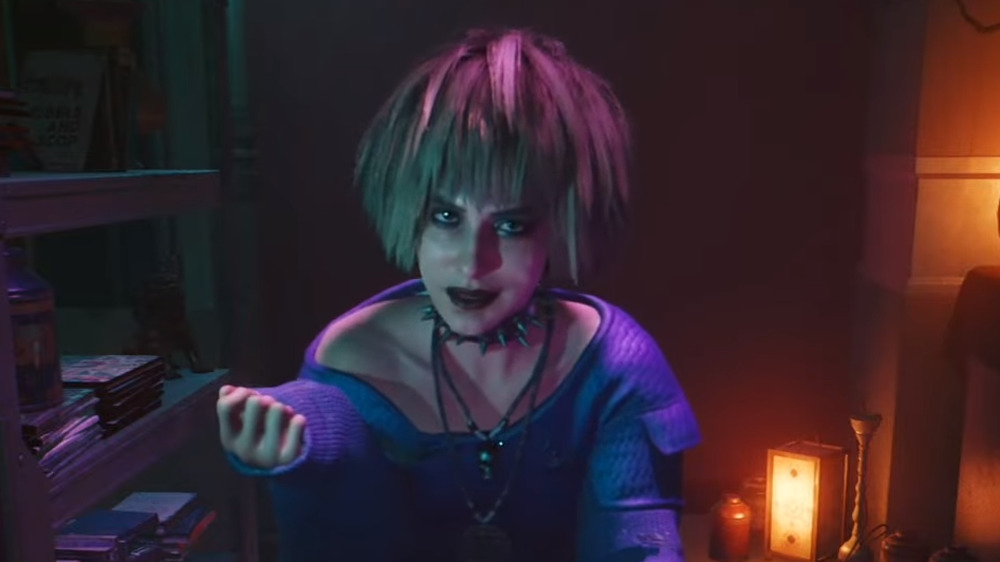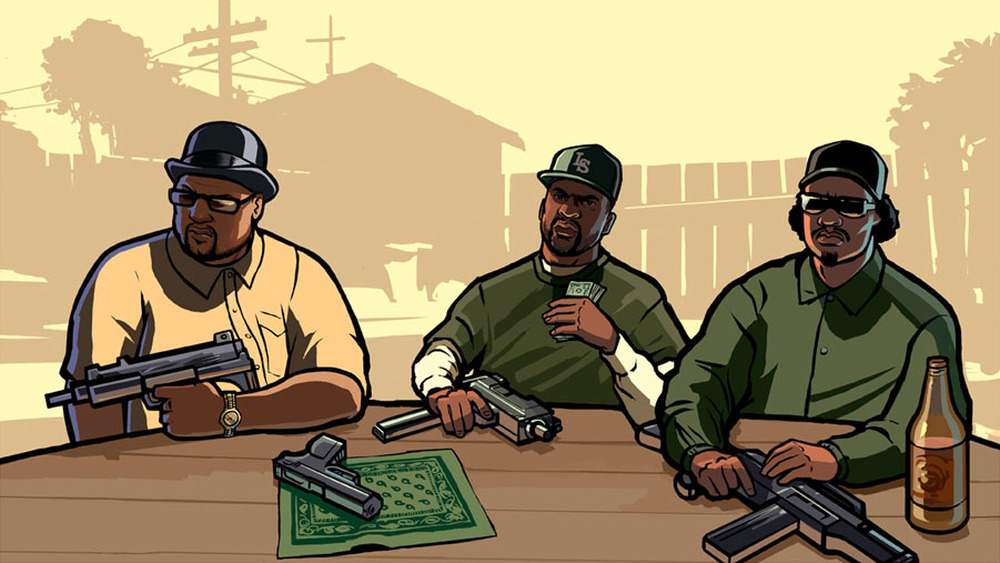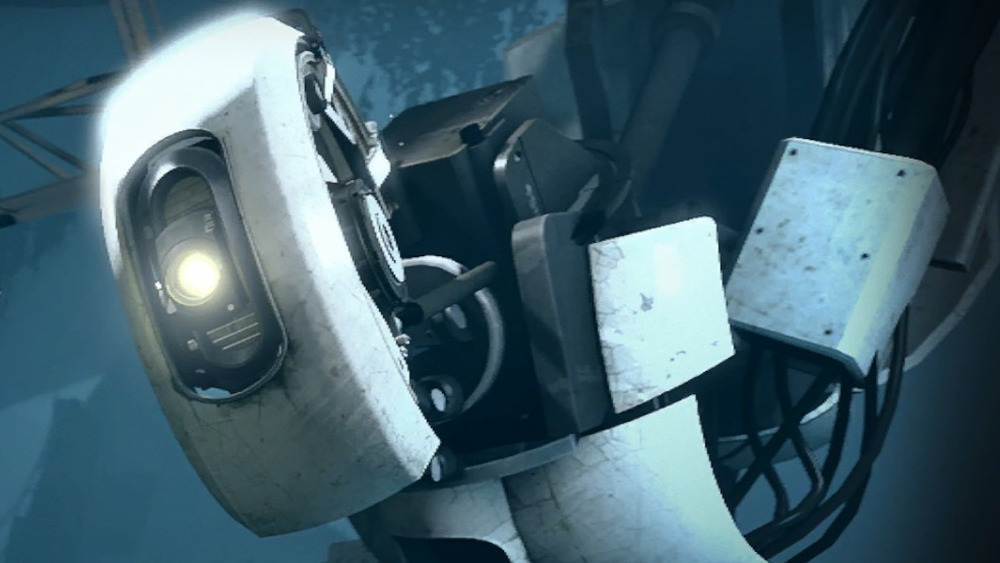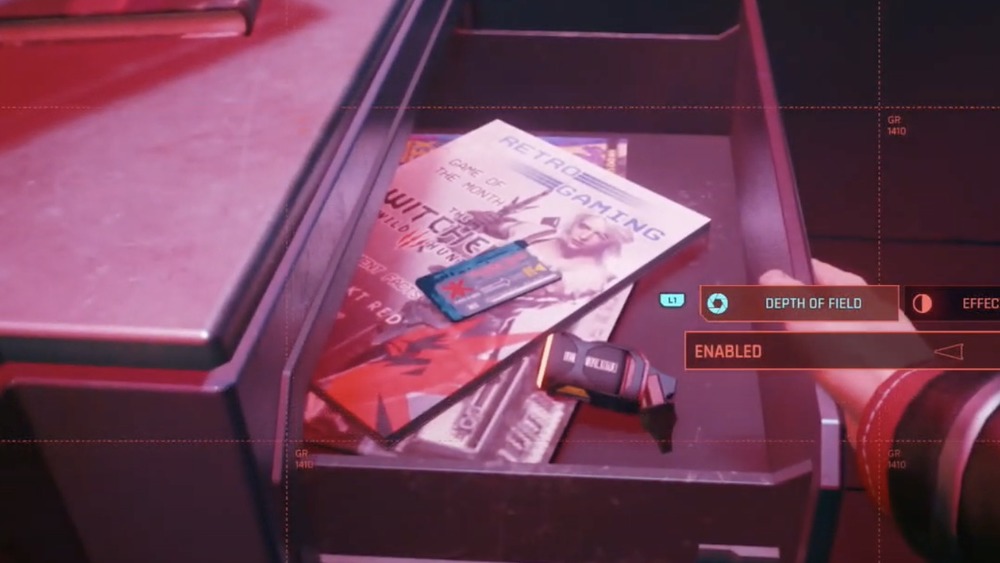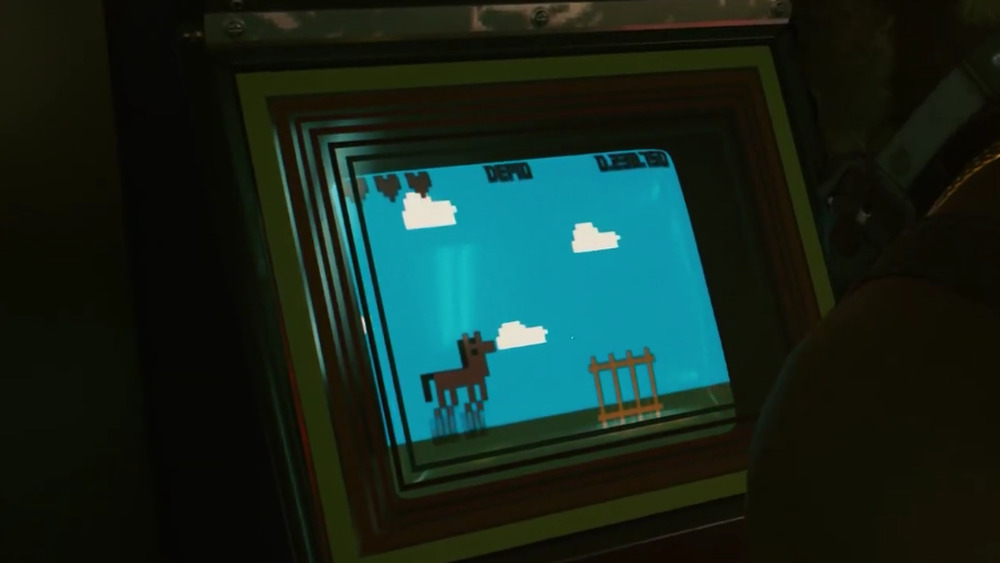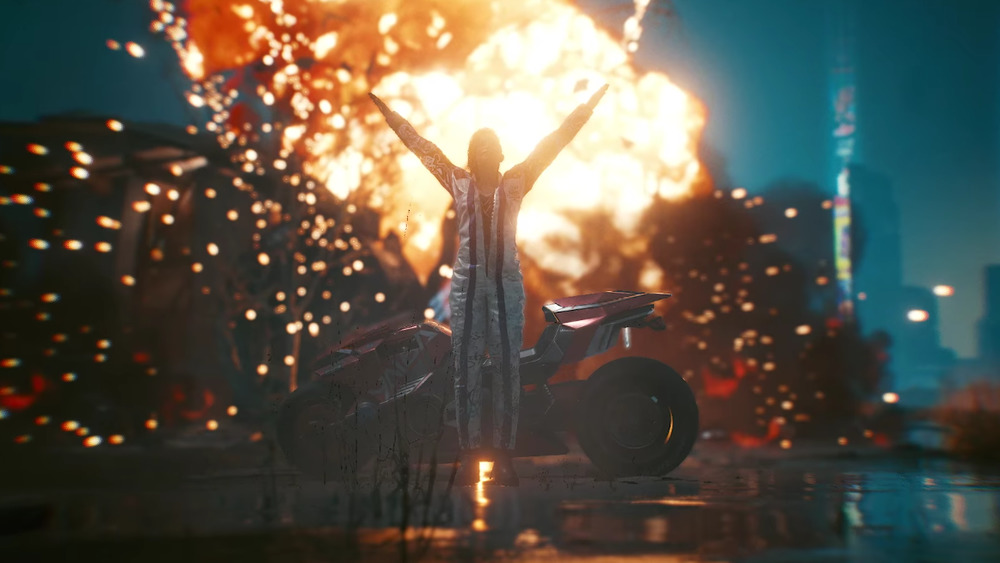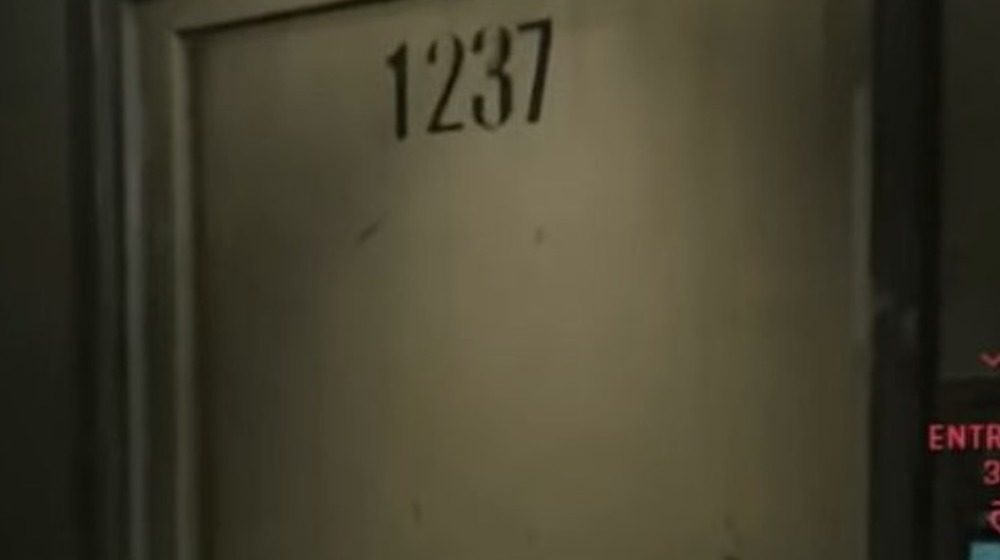Small Details You Missed In Cyberpunk 2077
After an excruciatingly long development period and subsequent wait for fans, CD Projekt, the video game developer behind the popular fantasy series The Witcher, released the futuristic sci-fi title Cyberpunk 2077 in December 2020. One of the most ambitious entries of all time, the game offers an extremely detailed and highly immersive experience as players control a customizable character named V, a mercenary in search of body hacks as they undergo various quests and missions in six distinct regions of the seedy and dystopian Night City, California. Picture Grand Theft Auto: Vice City but in a Blade Runner-like future with technology run amok — that's a pretty good idea of what the fascinating and engrossing Cyberpunk 2077 is like.
Because Cyberpunk 2077 is so heavily detailed — a fully-realized metropolis that players can freely explore — developers needed to load it up with as much material as possible. The result: It's oozing with subtle bits and pop culture references. Here are the sly Easter eggs and nods buried deep inside of Cyberpunk 2077.
It's just another day at The Office in Cyberpunk 2077
Should Cyberpunk 2077 players guide V into Afterlife, a bar owned by Night City fixer Rogue, they may find themselves getting into a discussion with an NPC named Dennis. This character will in turn introduce V to another character named Haruyoshi, who purports to have been a "brain surgeon, top of all" with "good instinct" back in Japan. He goes on to tell the story of how he was picked to perform brain surgery on the boss of the Tyger Claws, a crime syndicate discussed elsewhere in Cyberpunk 2077. But under his watch and his knife, the crime boss died, and the Tyger Claws held Haruyoshi responsible. So, he says, he stowed away on a boat and headed for America, where Dennis saved him.
This is all a lengthy homage to the American version of The Office. On the 2010 episode "Happy Hour," a man named Hide, short for Hidetoshi Hasegawa (played by Hidetoshi Immura), reported that in his old life in Japan, he was a world renowned heart surgeon who operated on a Yakuza boss and killed him, necessitating his escape by boat to the U.S., where Darryl (Craig Robinson) saved his life and gave him employment as a warehouse and dock worker at Dunder Mifflin.
Use the three seashells if the need strikes
The 1993 Sylvester Stallone movie Demolition Man could be considered part of the cyberpunk subgenre. Like Blade Runner or Cyberpunk 2077, it takes place in a not-so-distant future where technology allows for body mods and advanced artificial intelligence. Crime is rampant and it always seems to be night, the world lit by huge video screens and neon signs.
One odd joke from Demolition Man has survived for decades: When Stallone's character is unfrozen and wakes up in 2032, he's perplexed by the new way of cleaning oneself after using the restroom: toilet paper has been replaced by a system of three seashells, the exact use of which isn't explained in the film. Perhaps Cyberpunk 2077 takes place in the same fictional futuristic universe as Demolition Man, because the residents of Night City have apparently adopted the three seashells method of personal hygiene. Players can explore V's apartment and poke around the bathroom. Next to the toilet, just by a curtain sit three seashells, which apparently aren't just for decoration.
Judy Alvarez likes manga and Radiohead
The Cyberpunk 2077 locale Lizzie's Bar is the domain of a gang called the Moxes, where a character named Judy Alvarez runs a Braindance suite, offering paying customers illegal and illicit virtual reality-like experiences. As a tech expert, she also helps out protagonist V on their various Night City quests.
Whenever V puts in or receives a call from Judy, a box pops up on the player's screen depicting her avatar, a traditional rendering of a ghost (a wispy white figure) wearing a cute, smiling animal mask. Look a little closer, and that ghost is emerging from a red shell. In other words, this is literally a ghost in a shell, a subtle reference to Ghost in the Shell, the classic cyberpunk Japanese manga and anime franchise.
Judy is into other future-leaning pop culture that's positively ancient in the timeframe of Cyberpunk 2077. She's heavily tattooed, with some roses, the number "13" on her left arm, and some words scrawled on her left hand. A close look shows that it reads, "There was nothing to fear, nothing to doubt." That's a lyric from "Pyramid Song," a track off of Radiohead's 2001 album Amnesiac.
Hey, isn't that the creator of another game?
You know you're a hardcore gamer if you know what major video game developers look like. One such industry luminary is Hideo Kojima, who brought such important works as Death Stranding and the Metal Gear series to the world. He didn't work on Cyberpunk 2077, but he may have had an influence on its creators, as he knows how to build an immersive, addictive world.
CD Projekt Red's developers said thanks by including an image of Kojima in Cyberpunk 2077. In one of the main early quests called "The Heist," V arrives at Arasaka's hotel and checks in, but gets the chance to explore a hotel bar on the way to their room. That's where you'll notice a person who looks just like Kojima sitting in a booth and talking to some admirers, some of whom are seemingly pitching him movie ideas.
Cyberpunk 2077 is positively Batty
When you think of cyberpunk entertainment, the images that come to mind likely look like something out of Blade Runner, Ridley Scott's visionary and influential 1982 film based on a story by Philip K. Dick. Cyberpunk 2077 closely adheres to Scott's idea of the future, with Night City very much resembling Blade Runner's neon-in-the-dark, crime-and-android-riddled Los Angeles.
Cyberpunk may also conjure images of a major character from Blade Runner: combat replicant and uprising leader Roy Batty, as portrayed by Rutger Hauer. His last words are poetic, cryptic, and one of the most heart wrenching lines in film history: "All these moments will be lost time, like tears in the rain."
In Cyberpunk 2077, on the memorial building in the game's North Oak section, V can find a plaque decorated with the Blade Runner quote, and attributed to Roy Batty next to a properly funerary image of a dove. Batty makes a far more direct appearance in Vista Del Rey on the rooftop of a building there.
There's at least one more reference to Blade Runner within Cyberpunk 2077. A character named Misty runs a store called Misty Esoterica in the Watson District of Night City, which is also a front for cybernetic enhancement purchases. With her big blond hairstyle, lengthy bangs, spiky necklace, and dark eyeshadow, Misty bears a striking resemblance to Pris, the android girlfriend of Roy Batty.
Night City might be located near San Andreas
A mercenary wandering around a massive, seedy, frightening fictional city full of shady and morally flexible characters? That's the premise of Cyberpunk 2077, but it could also be used to describe some entries in the Grand Theft Auto series, particularly Vice City and San Andreas, two of the most popular (and clearly influential) immersive video game titles of the early 2000s.
San Andreas featured two of the best known characters in gaming: protagonist C.J. and bad guy Big Smoke, who were a big part of the San Andreas mission "Wrong Side of the Tracks." In Cyberpunk 2077, two minor characters make a brief appearance in a text sequence, and they're obviously a play on C.J. and Big Smoke in that their names are J.C. and Little Smoke. Unfortunately for them, both J.C. and Little Smoke wind up dead in Cyberpunk 2077, and the latter's remains are found with a half-eaten hamburger next to him, likely a nod to Big Smoke's big love of fast food.
Cyberpunk 2077 is a portal to Portal
In Cyberpunk 2077, you might encounter a quest that involves hunting down and rebooting a handful of AI-operated Delamain taxis that have seemingly turned evil, if not sentient. When V does track down one of these rogue cabs, the sound of the AI's voice, if not the dialogue it delivers, should probably feel familiar to seasoned gamers.
Central to the Portal series, as the villain in the first game and an antagonist-turned-somewhat protagonist in Portal 2, is GLaDOS, short for "Genetic Lifeform and Disk Operating System," a core that controls the Aperture Society's computerized Enrichment Center. It was programmed with a traditionally feminine character and voice, and a stone-cold personality, all of which are present when the taxi AI makes its presence felt in Cyberpunk 2077, accessible in "Epistrophy: Coastview" in the Pacifica area. This disembodied inhuman voice wants to test V and also threatens physical harm and ominously mentions that "all the cake is gone," a direct reference to Portal's most famous line.
References to The Witcher abound in Cyberpunk 2077
Prior to the long-awaited release of Cyberpunk 2077, developer CD Projekt was best known and most beloved for The Witcher, a series of role-playing medieval fantasy quest games based on stories by author Andrzej Sapkowski. CD Projekt programmers certainly have a special spot in their hearts for the company's previous contribution to gaming, which is evident in Cyberpunk 2077, despite taking place in a dystopian, sci-fi America far from the distant past of The Continent.
For example, there's a weapon V can obtain in the game, a katana known as "The Black Unicorn." That's the name of a sword brandished by Geralt in The Witcher 2 and 3. (It's reserved for gamers who purchased Cyberpunk 2077 via GOG, and the sword shows up in V's apartment, alongside some Witcher 3 clothing articles.)
In a meta, world-falling-in-on-itself kind of way, it would seem that The Witcher game series exists in the universe of Cyberpunk 2077. During the introduction to the "Corpo" lifepath, one a of three available in the game, players can explore an ordinary-looking desk. In one of the drawers is an issue of Retro Gamer, a magazine celebrating video games that are old in the futuristic year of 2077. On the cover, you'll find Ciri, a main character from that "retro" franchise, The Witcher.
That's a familiar looking horse, of course
Beyond Geralt of Rivia and Ciri, the breakout character from The Witcher series just might be Roach, the trusty and noble steed ridden by Geralt, and with whom he has a strong and profound bond. The world seems to love the horse decades into the future, when Cyberpunk 2077 is set, because he's all over the game.
Furthering the notion that The Witcher exists in this game's universe, there are video game cabinets in a Cyberpunk 2077 arcade locale inviting players in to play Roach Race. This isn't an actual game in the real world, but it is here, and it involves Roach participating in various activities reminiscent of the horse race in The Witcher.
Roach makes another quiet appearance in Cyberpunk 2077's world in the form of a sticker on V's car.
Photo Mode offers some snapshots of fun
As Fortnite offers players the chance to perform a silly, pop culture-inspired dance after a round of killing and bloodshed, so too does Cyberpunk 2077 lighten its pervasively dark, heavy, and unsettling tone with a feature in its Photo Mode. Players can take photos of their version of V during gameplay, and they can pose them in a number of pre-programmed and named positions, all of them references to movie, games, TV shows, and even memes.
Among the listed options are "Joker Stairs," which captures V looking like the Joker from Joker dancing on a staircase. V can also strike a winning Dark Souls pose with the "V for Victory" entry, or evoke the aghast reaction of the South Park kids with "Oh My God! They Killed V!" Drake's much-repeated and reworked "Hotline Bling"-video based meme can be found under the title "Hard Pass / Now You're Talking." Other poses are inspired by Jojo's Bizarre Adventure, Titanic, Sailor Moon, and Pulp Fiction.
Cyberpunk 2077 has the Shining
Stanley Kubrick's 1980 film The Shining is a landmark in horror film. Both a psychological thriller and supernatural tale, it's about the evil spirits that lead to a lot of death, murder, ghosts, and mental breakdowns for the Torrance family, who agree to be the winter caretakers of a clearly haunted hotel.
In one of the film's most mind-boggling and terrifying sequences, Jack Torrance (Jack Nicholson) passionately makes out with a naked woman who emerges from a bath, only for her to transform into her true form, that of a monstrous dead person. That all goes down in Overlook Hotel room number 237, a destination so significant that it became the name of a movie about The Shining. It's also referenced in Cyberpunk 2077. As V and Jackie walk around Arasaka's hotel, they encounter room number 1237. Inside, a dead woman is found in a bathtub.

